Words: Sydney Huffman, Malta Dymanics
Photos: Malta Dynamics
Personal Protective Equipment (PPE) is crucial for ensuring the safety and well-being of workers across various industries. From construction sites to manufacturing plants, proper maintenance of PPE is paramount to ensure its effectiveness in protecting against workplace hazards. In this comprehensive guide, we dive into the importance of PPE care and maintenance, along with best practices to keep your gear in top condition.
Why PPE Maintenance Matters
PPE serves as the first line of defense against a wide range of occupational hazards, including falls, impact, chemical exposure, and more. However, without proper care and maintenance, even the most advanced protective gear can fail to provide adequate protection. Here’s why PPE maintenance should be a top priority:
- Enhanced Safety: Well-maintained PPE functions as intended, offering reliable protection against workplace hazards. Regular inspections and maintenance help identify any defects or wear and tear that could compromise safety.
- Extended Lifespan: Proper care can significantly extend the lifespan of PPE, saving costs associated with frequent replacements. This ensures that workers have access to high-quality protective gear without compromise.
- Compliance: Regulatory standards often mandate regular inspection and maintenance of PPE to ensure compliance with safety regulations. Failure to adhere to these standards can result in penalties and, more importantly, increased risk to workers.
Best Practices for PPE Care and Maintenance
Effective maintenance of PPE involves a combination of routine inspections, cleaning, storage, and timely replacement when necessary. Here are some essential best practices to consider:
- Regular Inspections: Conduct thorough inspections of PPE before each use to identify any signs of damage, such as cracks, tears, or broken components. Follow manufacturer guidelines for specific inspection procedures tailored to each type of PPE.
- Cleaning: Proper cleaning is essential for removing dirt, debris, and contaminants that may compromise the integrity of PPE. Use mild soap and water for cleaning, avoiding harsh chemicals that could damage materials. Allow PPE to air dry thoroughly before storage or reuse.
- Storage: Store PPE in a clean, dry, and well-ventilated area away from direct sunlight and extreme temperatures. Hanging equipment such as harnesses and lanyards can help prevent deformation and ensure proper drying after cleaning.
- Maintenance Records: Maintain detailed records of inspections, maintenance activities, and any repairs performed on PPE. This documentation not only demonstrates compliance with regulatory requirements but also helps track the lifespan of equipment and identify patterns of wear and tear.
- Timely Replacement: Despite regular maintenance, PPE has a finite lifespan and will eventually need replacement. Establish clear criteria for determining when to retire equipment based on factors such as age, usage frequency, visible wear, and manufacturer recommendations.
Key PPE Maintenance Tips by Malta Dynamics
As leaders in the industry, Malta Dynamics emphasizes the following additional tips for ensuring the optimal care and maintenance of PPE:
- Harness and Fall Protection Systems: Inspect harnesses, lanyards, and other fall protection equipment for signs of wear, including frayed edges, corrosion, or loose stitching. Replace any components that show signs of damage to maintain the integrity of the system.
- Anchorage Points: Regularly inspect anchorage points for structural integrity and proper installation. Ensure that anchorages are capable of supporting the intended load and are free from damage or deterioration.
- Respiratory Protection: Follow manufacturer guidelines for cleaning and disinfecting respiratory protective equipment such as masks and respirators. Inspect seals, valves, and straps regularly to ensure a proper fit and seal.
- Eye and Face Protection: Clean and sanitize goggles, face shields, and safety glasses after each use to prevent the buildup of dirt and contaminants. Inspect lenses for scratches or cracks that could impair vision and replace them as needed.
- Hand Protection: Wash gloves regularly with mild soap and water to remove dirt and sweat, paying particular attention to areas between fingers. Inspect gloves for punctures, tears, or signs of degradation and replace them if compromised.
By adhering to these best practices and tips provided by industry leaders like Malta Dynamics, employers can uphold the highest standards of safety and ensure the continued protection of their workforce.
Proper care and maintenance of PPE are essential for preserving its effectiveness and safeguarding the well-being of workers. By implementing routine inspections, cleaning protocols, and storage practices, employers can prolong the lifespan of PPE and mitigate the risk of workplace injuries. As a trusted resource in the industry, Malta Dynamics advocates for the adoption of best practices to promote a culture of safety and compliance in all workplace environments.
